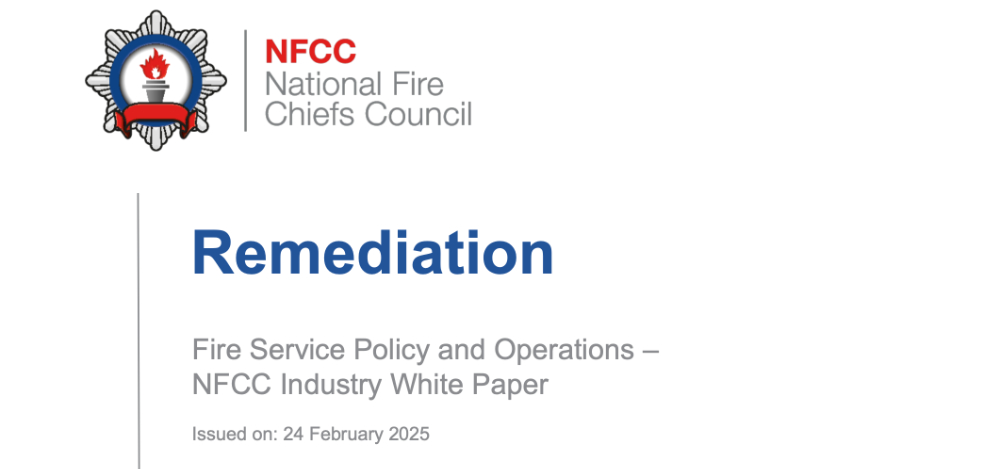National Fire Chiefs Council publishes Industry White Paper on Remediation
On 24 February The National Fire Chiefs Council (NFCC) publshed its white paper entitled 'Remediation- Fire Service Policy and Operations
The paper examines the role of fire and rescue services (FRSs) in remediating unsafe buildings, aligning with the Government’s renewed focus on the issue. FRSs have been responsible for assessing the risks in high-rise flats to ensure that affected residents are safe, despite, it says, 'workforce challenges'.
The reports notes that its work has in turn highlighted broader barriers that hinder dutyholders from meeting safety obligations and calls for a coordinated approach to address these issues. Led by NFCC, with incorporated input from cross-sector stakeholders the white paper proposes solutions for collaboration between NFCC, FRSs, the Government, developers, and stakeholders as a route to creating a safer built environment.
In its summary the report reiterates that the Grenfell Tower tragedy exposed systemic safety failures, and highlights the urgent need to remediate unsafe residential buildings. The crucial role Fire and rescue services (FRSs) have played in safeguarding communities, has made clearer that remediation efforts still face persistent barriers. While the safety of cladding remains a key focus, it notes that many buildings suffer from serious internal fire safety issues. The NFCC advocates for a centrally coordinated programme to address challenges, enhance interagency collaboration, improve legislative tools, and align remediation with workforce competence. A risk-based, collaborative approach: integrating regulatory support, funding, certified materials, and skilled professionals is essential to ensuring lasting building safety improvements.
Whilst the Remediation Acceleration Plan published by the Government published in December, commits to the complete remediation of all buildings over 18 metres in height by the end of 2029. However MHCLG estimates that up to 12,000 buildings over 11 metres tall also need to be remediated, with 60% still to be identified, these are currently also inteneded to be completed by the end of 2029. The NFCC White Paper sets out a warning that under the existing capacities, in terms of reviewing and or inspect 11-18 metre mid rise buildings would take between 12 and 24 years at an estimated cost of between £200 to £600 million.
The report goes on to highlight with a the three-to-five year training required and current shortages in available workforce funding is not the only issue. As such it is requesting the establishment of a cross-departmental Construction Skills Strategy to address the chronic shortages fire engineers, fire risk assessors and other professional roles. Whilst the focus in these roles is to protect communities, this includes wider externalities beyong fire that are also increasing in occurance such as extreeme weather events.
The full report can be found here 'Remediation: Fire Service Policy and Operations –NFCC Industry White Paper' published by the National Fire Chiefs Council (NFCC) on 24 February 2025.
[edit] Related articles on Designing Buildings
- ACM cladding.
- Adaptation.
- Approved Document B.
- BS 8414 Fire performance of external cladding systems.
- Building Safety wiki.
- Building a safer future: an implementation plan.
- Celotex RS5000 PIR insulation.
- CIAT response to Grenfell inquiry.
- Climate
- Construction quality management guide.
- Disaster.
- Drought.
- Exceptionally adverse weather.
- Extraordinary weather event.
- Extreme weather.
- Fire performance of external thermal insulation for walls of multistorey buildings, third edition (BR 135).
- Flood.
- Grenfell Tower articles.
- Grenfell Tower fire
- Grenfell Tower independent expert advisory panel.
- Grenfell Tower Inquiry Phase 1 Report.
- Grenfell Tower Inquiry Phase 2 Report.
- Independent review of the building regulations and fire safety.
- Joint Competent Authority.
- Lakanal House fire.
- National construction products regulator established.
- Ronan Point.
- The Regulatory Reform (Fire Safety) Order 2005.
- Torre Windsor office building fire.
- Weather.
Quick links
[edit] Legislation and standards
Fire Safety (England) Regulations 2022
Regulatory Reform (Fire Safety) Order 2005
Secondary legislation linked to the Building Safety Act
Building safety in Northern Ireland
[edit] Dutyholders and competencies
BSI Built Environment Competence Standards
Competence standards (PAS 8671, 8672, 8673)
Industry Competence Steering Group
[edit] Regulators
National Regulator of Construction Products
[edit] Fire safety
Independent Grenfell Tower Inquiry
[edit] Other pages
Building Safety Wiki is brought to you courtesy of:






